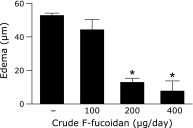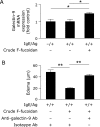F-fucoidan from Saccharina japonica is a novel inducer of galectin-9 and exhibits anti-allergic activity
- PMID: 27499575
- PMCID: PMC4933687
- DOI: 10.3164/jcbn.15-144
F-fucoidan from Saccharina japonica is a novel inducer of galectin-9 and exhibits anti-allergic activity
Abstract
Fucoidan is a sulfated polysaccharide from brown sea algae. In the present study, it was demonstrated that oral administration of F-fucoidan from Saccharina japonica possessed anti-allergic effects using the passive cutaneous anaphylaxis reaction, but not by intraperitoneal administration. The inhibitory mechanism was dependent on galectin-9, which belongs to a soluble lectin family that recognizes β-galactoside and prevents IgE binding to mast cells. The anti-allergy properties of F-fucoidan were cancelled by an intravenous dose of anti-galectin-9 antibody or lactose, which bind competitively with galectin-9 before the passive cutaneous anaphylaxis reaction. F-fucoidan increased the expression level of galectin-9 mRNA in intestinal epithelial cells and serum galectin-9 levels. Oral treatment with F-fucoidan suppressed allergic symptoms through the induction of galectin-9. This is the first report that F-fucoidan can induce the secretion of galectin-9.
Keywords: F-fucoidan; allergy; galectin-9.
Figures






References
-
- Hirabayashi J, Hashidate T, Arata Y, et al. Oligosaccharide specificity of galectins: a search by frontal affinity chromatography. Biochim Biophys Acta. 2002;1572:232–254. - PubMed
-
- Rabinovich GA, Toscano MA. Turning ‘sweet’ on immunity: galectin–glycan interactions in immune tolerance and inflammation. Nat Rev Immunol. 2009;9:338–352. - PubMed
-
- Liu FT, Rabinovich GA. Galectins as modulators of tumour progression. Nat Rev Cancer. 2005;5:29–41. - PubMed
-
- Wada J, Kanwar YS. Identification and characterization of galectin-9, a novel beta-galactoside-binding mammalian lectin. J Biol Chem. 1997;272:6078–6086. - PubMed
-
- Seki M, Oomizu S, Sakata K, et al. Galectin-9 suppresses the generation of Th17, promotes the induction of regulatory T cells, and regulates experimental autoimmune arthritis. Clin Immunol. 2008;127:78–88. - PubMed
LinkOut - more resources
Full Text Sources
Other Literature Sources
Research Materials

